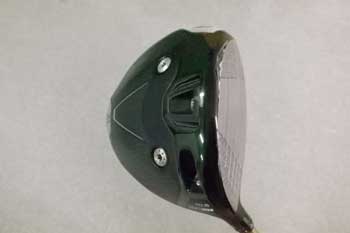Test Review: Callaway PARADYM MAX FAST Driver
Today, I tested the Callaway PARADYM MAX FAST Driver.

The shaft is the SPEEDER NX 40 for Callaway. The loft is 10.5°, the club length is 45.75 inches, shaft flex is R, shaft weight is 46g, torque is 5.6, kick point is mid, and the total club weight is 276g.

The Callaway PARADYM MAX FAST is a new driver. I recently tested the fairway wood, and today I had the opportunity to test the driver.

With the new PARADYM name, the design has been completely refreshed and looks great. While the EPIC series was fantastic, I think this PARADYM series is also very impressive. Callaway clubs are known for their mechanical and technical beauty rather than a simple, basic design.
The head itself is large and shallow, and there’s no noticeable change from previous models.

The backface has a large weight, and I saw the number “5,” so I assume it’s a 5g weight. There may be other weight options available as well.

Since it’s labeled “MAX FAST,” it’s likely designed for maximum speed. Just like the fairway wood I tested earlier, this driver also features “FORGED CARBON” and “JAIL BREAK AI.”

The neck length is slightly shorter but still standard for modern drivers. I was surprised that it doesn’t have an adjustable hosel system.

The face design is very unique. There’s a fine, beautiful milling-like pattern, and it’s interesting to see such attention to detail in a feature that most manufacturers neglect.

The toe is marked with “FORGED Ti,” indicating the use of forged titanium for the face. This contrasts with rival manufacturers like TaylorMade, who use carbon faces, which could be Callaway’s answer to that.

The shallow head is familiar, and it seems more “slanted” than just “thin.”

Honestly, I wasn’t fond of the face design. It has some familiar elements, but I personally didn’t like it. The most striking feature is the bulging backface, especially on the heel side. It gives the driver a “droopy-eyed” or “tanuki face” look, which makes it prone to a hook.
In contrast, if the toe side bulged more, it could look like a “fox face” and promote a fade-friendly setup. I prefer a more neutral face.

The carbon composite design looks sleek, but I found the carbon crown’s “joining parts” to be disappointing. There was a noticeable adhesive seam that was visible even without a close look, which was unfortunate. This detail, though small, can detract from the overall quality impression.

The grip has the Callaway logo, and it looks great. However, I wondered why they used “V” instead of “C” for the logo. It’s made by Golf Pride.

The shaft is very light, in the 40g range, and it feels thin. This makes it a softer flex, which is likely the standard for this driver.

At address, I didn’t feel particularly excited, but I wasn’t stiff either. I just set up normally. The loft is 10.5°, but at address, the face looks like it could have a loft of over 12°, similar to a 5-wood or brassie. The launch trajectory feels more like a hook rather than a high draw, so I adjusted my aim slightly to the right.
Test Shots Begin

The feel at impact is decent—not soft but a little firm, with a quick release. It’s not a bad feel, but it felt somewhat “rough” with some inconsistency. The ball jumps well, but it lacks that sensory appeal.

The sound is a bit louder than I expected but not overly high or large. It’s very typical of Callaway drivers, and this model falls on the quieter end of the spectrum.

The ball goes up easily, and it’s quite forgiving, which is a defining feature of this driver. The ball gets airborne easily, just like the fairway wood, making it feel more like a fairway wood than a driver. It’s easy to hit, and the ball stays in the air for a longer period.

The stability is impressive, with the ball behaving consistently. I didn’t notice any significant deviation in shots. The driver suits players who benefit from a forgiving, one-directional ball flight.

The distance performance is quite good, and I feel that this driver is more suited for swing-type players rather than hit-type players. Callaway drivers are generally known for their distance capabilities, and this one lives up to that reputation.
Post-Test Impressions
The new design looks great, and this driver is very lightweight and forgiving, making it ideal for many golfers, especially seniors and women. It’s designed to generate distance with ease, but for players like me who struggle with hooks, it might not be the best fit.

The forgiveness and launchability make it easy to hit, but I personally found it a bit too forgiving, especially since it tends to hook more than I prefer.

While the Callaway brand continues to innovate, this model feels more like an evolution of past designs. It’s clear that there’s a growing trend toward easy-to-hit drivers that offer forgiveness and high launch, making it an excellent choice for many players.
☆ Performance Ratings ☆
Ease of Setup: ☆☆
Feel at Impact: ☆☆
Sound: ☆☆☆
Launchability: ☆☆☆☆
Stability: ☆☆☆☆
Distance Performance: ☆☆☆☆
Workability: ☆
Want to read the original article in Japanese? Click here










